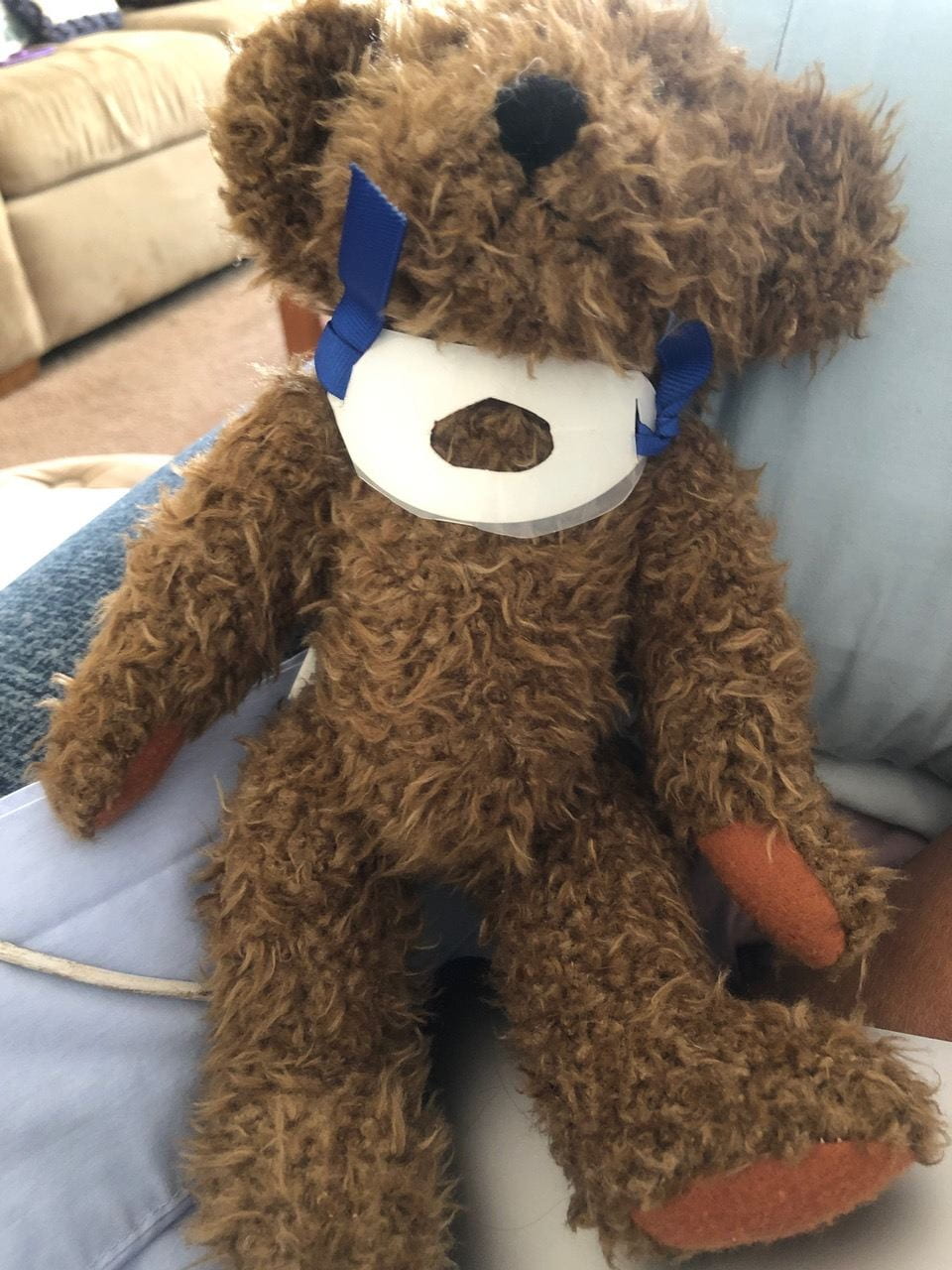Nurses Practice Tracheostomy Care (and More) from Home
Coco the stuffed teddy bear lay calmly on the table. She wasn’t worried about what was about to happen. Neither was SJSU instructor Linda Higgins, a lecturer in the SJSU Valley Foundation School of Nursing, who had borrowed Coco from her 10-year-old granddaughter Kiersten. Tools in hand, Higgins was about to perform Coco’s tracheostomy care. A small tube called an inner cannula entered Coco’s throat through a water bottle top, held in place with a plastic lid and some leftover ribbons.
COVID-19 or no, Higgins would demonstrate sterile trach care to her nursing students—hands on, the only way she could.
An ICU nurse for 17 years, Higgins is a nurse “first and foremost,” she says. She and co-teacher Renee Billner-Garcia learned on a Wednesday last spring that all classes would resume online the following Monday. The two were “nonstop on the telephone,” Higgins says, figuring out how to teach hands-on skills remotely while students were sheltering in place.
Normally, groups of students would practice three procedures on mannequins in the nursing school’s simulation lab. The first is sterile procedure for changing dressings on a central line, a type of chest IV that runs straight into the heart. Required skills include correct placement of the sterile kit and keeping hands above the table surface level to ensure sterile conditions.
Second is tracheostomy care. Skills include how to suction—trach patients may be unable to cough secretions—and how to properly clean around the throat tubes. Trach patients have a “faceplate” holding the trach tube in place with ties, which must be changed out, Higgins explains. “Trach care has an inner cannula, a four-inch curved tube that goes into the tracheostomy stoma, or hole. As a demonstration I fashioned a faceplate out of the top of a parmesan cheese container lid with ribbons attached,” she says.
“For student nurses, Higgins says, ‘Excellent communication skills are hugely important.'”
Remote learning meant students would have to fashion their own mannequins—the way Higgins had demonstrated on video with Coco. And the students were “unbelievably creative,” Higgins says. When they couldn’t even shop for materials, some invented practice dummies out of plastic water bottles with holes cut into them. When students simulated the technique, “it was very primitive—but it worked!” Higgins marvels.
The third and most challenging procedure was Foley catheter insertion into a patient’s urethra, Higgins says, and student nurses can start out scared and intimidated. “It’s not easily replicated in a home setting. We considered just having them take it as an incomplete.” But Billner-Garcia is “disturbingly creative,” Higgins laughs. She had her son videotape her demonstrating Foley catheter insertion with the help of some limbs fashioned from towels, washcloths and pillows. Towels represented patient legs, which had to be positioned correctly. The folded washcloth substituted for genitalia, and the pillow stood in for a torso. “So that was our patient,” Higgins laughs.
To show their mastery of the procedure, students shot footage of themselves using their own GoPros, iPads or phones to capture multiple angles. COVID-19 prohibited them from visiting and assisting each other, as they typically would in the lab. Higgins and Billner-Garcia reviewed hours of videos from 60 students, offered feedback, and encouraged the nursing students to correct any sterility failures and resubmit final videos for a grade.
Once underway, student resourcefulness again prevailed. Higgins received a text from Billner-Garcia that read, “Holy cow, I have vegetables.”
To fashion simulated human anatomy, students deployed whatever they had on hand, cutting holes in zucchinis and cucumbers to practice catheter insertion. “Vegetables,” Higgins laughs. “It was not inappropriately done, but it was funny. It showed their creativity.” Higgins says they were motivated to get hands-on practice approximating real-world conditions because they understood that permission to do clinical practice in hospitals was severely restricted.
Fall semester classes have no fewer students than before, she adds, because once they are accepted and enroll, most SJSU nursing students don’t want to interrupt the program, Higgins says. The SJSU nursing students are eager to keep going, knowing full well that California has a shortage of qualified nurses. “We have the cream of the crop,” Higgins says.
It’s all quite stressful for the student nurses, Higgins emphasizes, so she and Billner-Garcia are involved in plenty of nurturing—supporting students individually via one-on-one texts, phone calls, and Zoom calls.
In August, Higgins and Billner-Garcia got permission to go to campus. At the simulation lab, they prepared a semester’s worth of nursing apparatus. On “one of those 100-degree days,” Higgins says, they bagged supplies like sterile gloves into eight-gallon Ziplocs and assembled kits. Billner-Garcia tossed the kits into her car trunk and met students in an SJSU parking lot, where, to minimize contact, the nursing students even brought their own pens to sign out the materials they would practice with during the semester.
The instructors added a peer review system for videos, so students can redo their work before they are graded, she says. “We told them this isn’t film school—the video needs to follow your hands” more than display production quality and polished cinema. While they maintain the sterile field, the students are evaluated on how well they communicate to those pillows or water bottles—their patients. “They have to act it out, talking,” Higgins says. “Excellent communication skills are hugely important.”
Higgins’ instructional presentations are now asynchronous—to her old Powerpoint she has added narrative and captions. Being able to watch and learn outside of class time allows the entire class to join a synchronous Zoom that’s only about practicing. Higgins and Billner-Garcia hop among Zoom breakout rooms instead of moving around the physical classroom from mannequin to mannequin. Later, she says, clinical nursing staff will know the students have practiced virtually, and they will be supervised carefully when they finally get to do procedures on human patients.
“The quality of hands-on learning is still there,” Higgins says. “They learned these procedures every bit as much as students in previous semesters. In fact, they are probably doing it better, because they are getting more practice so their videos are terrific.”




